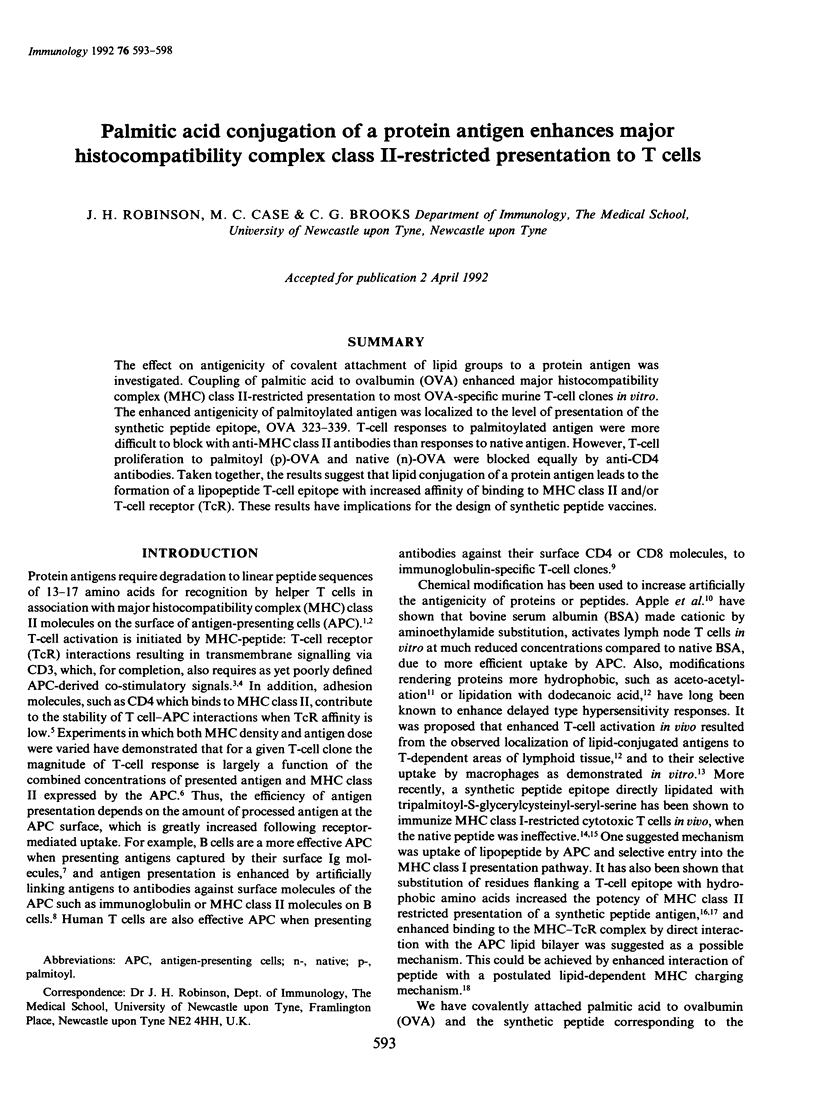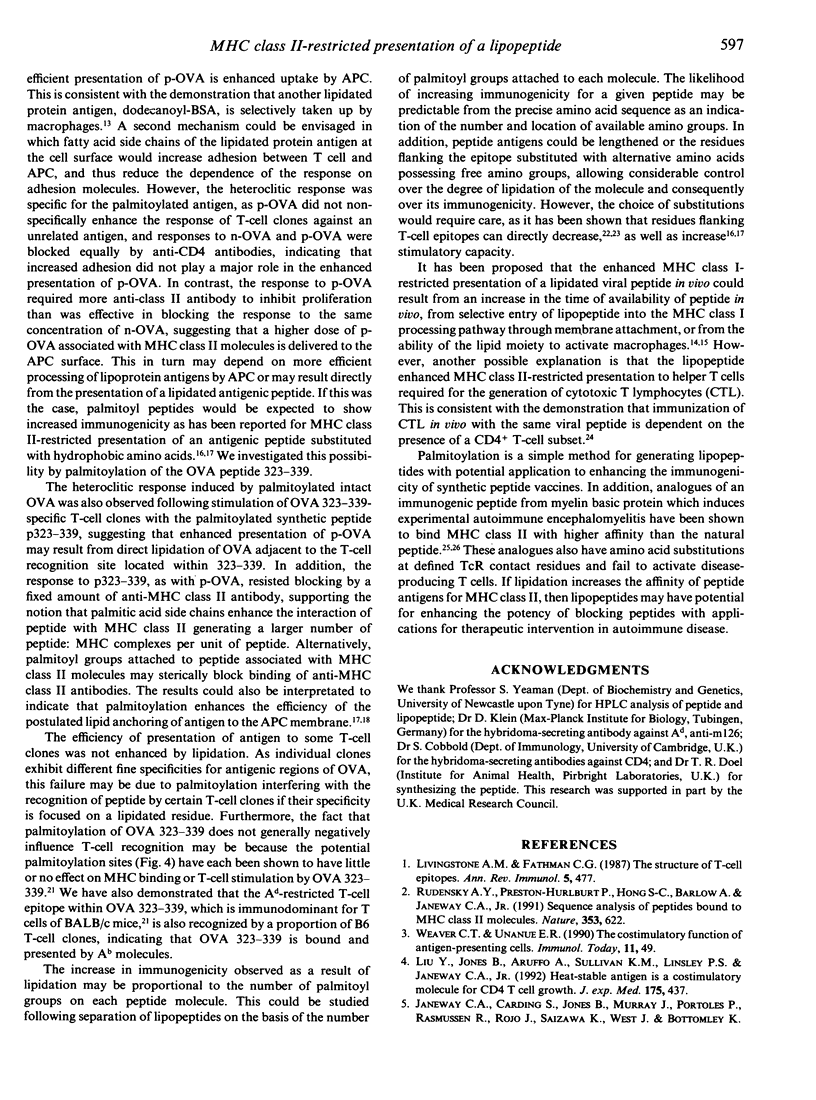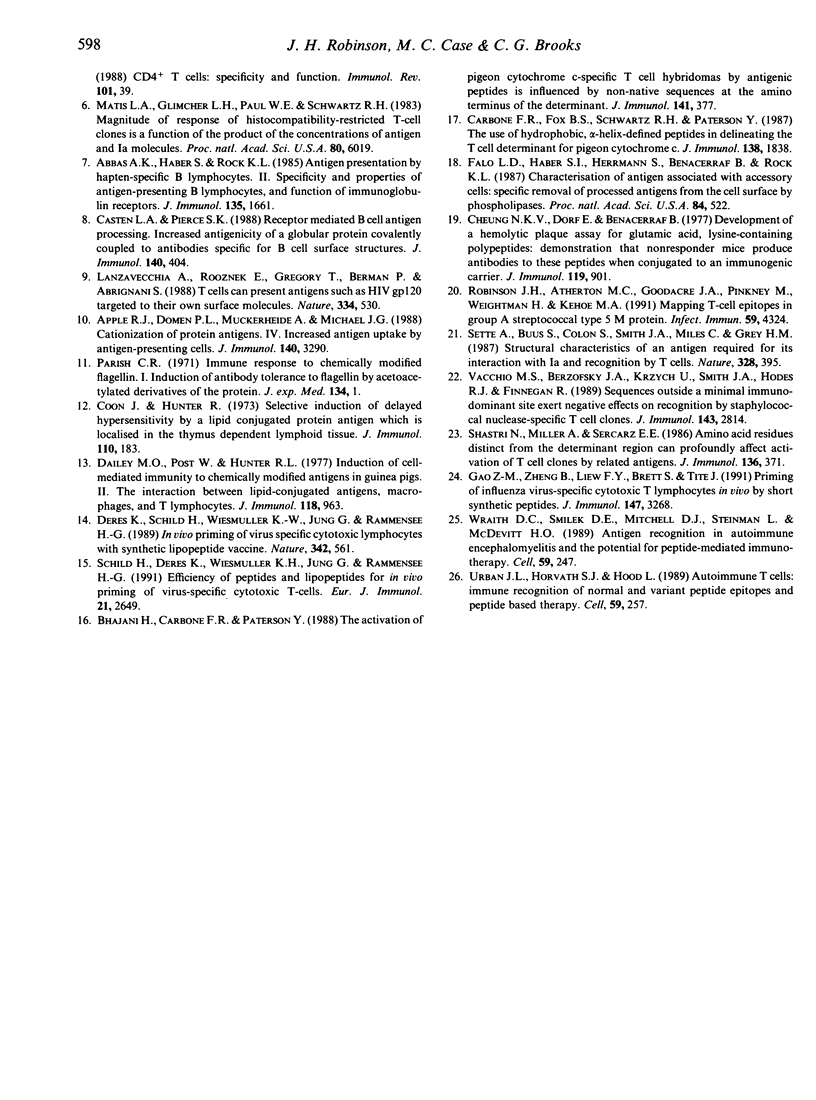Abstract
The effect on antigenicity of covalent attachment of lipid groups to a protein antigen was investigated. Coupling of palmitic acid to ovalbumin (OVA) enhanced major histocompatibility complex (MHC) class II-restricted presentation to most OVA-specific murine T-cell clones in vitro. The enhanced antigenicity of palmitoylated antigen was localized to the level of presentation of the synthetic peptide epitope, OVA 323-339. T-cell responses to palmitoylated antigen were more difficult to block with anti-MHC class II antibodies than responses to native antigen. However, T-cell proliferation to palmitoyl (p)-OVA and native (n)-OVA were blocked equally by anti-CD4 antibodies. Taken together, the results suggest that lipid conjugation of a protein antigen leads to the formation of a lipopeptide T-cell epitope with increased affinity of binding to MHC class II and/or T-cell receptor (TcR). These results have implications for the design of synthetic peptide vaccines.
Full text
PDF





Selected References
These references are in PubMed. This may not be the complete list of references from this article.
- Abbas A. K., Haber S., Rock K. L. Antigen presentation by hapten-specific B lymphocytes. II. Specificity and properties of antigen-presenting B lymphocytes, and function of immunoglobulin receptors. J Immunol. 1985 Sep;135(3):1661–1667. [PubMed] [Google Scholar]
- Apple R. J., Domen P. L., Muckerheide A., Michael J. G. Cationization of protein antigens. IV. Increased antigen uptake by antigen-presenting cells. J Immunol. 1988 May 15;140(10):3290–3295. [PubMed] [Google Scholar]
- Bhayani H., Carbone F. R., Paterson Y. The activation of pigeon cytochrome c-specific T cell hybridomas by antigenic peptides is influenced by non-native sequences at the amino terminus of the determinant. J Immunol. 1988 Jul 15;141(2):377–382. [PubMed] [Google Scholar]
- Carbone F. R., Fox B. S., Schwartz R. H., Paterson Y. The use of hydrophobic, alpha-helix-defined peptides in delineating the T cell determinant for pigeon cytochrome c. J Immunol. 1987 Mar 15;138(6):1838–1844. [PubMed] [Google Scholar]
- Casten L. A., Pierce S. K. Receptor-mediated B cell antigen processing. Increased antigenicity of a globular protein covalently coupled to antibodies specific for B cell surface structures. J Immunol. 1988 Jan 15;140(2):404–410. [PubMed] [Google Scholar]
- Cheung N. K., Dorf M. E., Benacerraf B. Development of a hemolytic plaque assay for glutamic acid, lysine-containing polypeptides: demonstration that nonresponder mice produce antibodies to these peptides when conjugated to an immunogenic carrier. J Immunol. 1977 Sep;119(3):901–905. [PubMed] [Google Scholar]
- Coon J., Hunter R. Selective induction of delayed hypersensitivity by a lipid conjugated protein antigen which is localized in thymus dependent lymphoid tissue. J Immunol. 1973 Jan;110(1):183–190. [PubMed] [Google Scholar]
- Dailey M. O., Post W., Hunter R. L. Induction of cell-mediated immunity to chemically modified antigens in guinea pigs. II. The interaction between lipid-conjugated antigens, macrophages, and T lymphocytes. J Immunol. 1977 Mar;118(3):963–970. [PubMed] [Google Scholar]
- Deres K., Schild H., Wiesmüller K. H., Jung G., Rammensee H. G. In vivo priming of virus-specific cytotoxic T lymphocytes with synthetic lipopeptide vaccine. Nature. 1989 Nov 30;342(6249):561–564. doi: 10.1038/342561a0. [DOI] [PubMed] [Google Scholar]
- Falo L. D., Jr, Haber S. I., Herrmann S., Benacerraf B., Rock K. L. Characterization of antigen association with accessory cells: specific removal of processed antigens from the cell surface by phospholipases. Proc Natl Acad Sci U S A. 1987 Jan;84(2):522–526. doi: 10.1073/pnas.84.2.522. [DOI] [PMC free article] [PubMed] [Google Scholar]
- Gao X. M., Zheng B., Liew F. Y., Brett S., Tite J. Priming of influenza virus-specific cytotoxic T lymphocytes vivo by short synthetic peptides. J Immunol. 1991 Nov 15;147(10):3268–3273. [PubMed] [Google Scholar]
- Lanzavecchia A., Roosnek E., Gregory T., Berman P., Abrignani S. T cells can present antigens such as HIV gp120 targeted to their own surface molecules. Nature. 1988 Aug 11;334(6182):530–532. doi: 10.1038/334530a0. [DOI] [PubMed] [Google Scholar]
- Liu Y., Jones B., Aruffo A., Sullivan K. M., Linsley P. S., Janeway C. A., Jr Heat-stable antigen is a costimulatory molecule for CD4 T cell growth. J Exp Med. 1992 Feb 1;175(2):437–445. doi: 10.1084/jem.175.2.437. [DOI] [PMC free article] [PubMed] [Google Scholar]
- Livingstone A. M., Fathman C. G. The structure of T-cell epitopes. Annu Rev Immunol. 1987;5:477–501. doi: 10.1146/annurev.iy.05.040187.002401. [DOI] [PubMed] [Google Scholar]
- Matis L. A., Glimcher L. H., Paul W. E., Schwartz R. H. Magnitude of response of histocompatibility-restricted T-cell clones is a function of the product of the concentrations of antigen and Ia molecules. Proc Natl Acad Sci U S A. 1983 Oct;80(19):6019–6023. doi: 10.1073/pnas.80.19.6019. [DOI] [PMC free article] [PubMed] [Google Scholar]
- Parish C. R. Immune response to chemically modified flagellin. I. Induction of antibody tolerance to flagellin by acetoacetylated derivatives of the protein. J Exp Med. 1971 Jul 1;134(1):1–20. doi: 10.1084/jem.134.1.1. [DOI] [PMC free article] [PubMed] [Google Scholar]
- Robinson J. H., Atherton M. C., Goodacre J. A., Pinkney M., Weightman H., Kehoe M. A. Mapping T-cell epitopes in group A streptococcal type 5 M protein. Infect Immun. 1991 Dec;59(12):4324–4331. doi: 10.1128/iai.59.12.4324-4331.1991. [DOI] [PMC free article] [PubMed] [Google Scholar]
- Rudensky AYu, Preston-Hurlburt P., Hong S. C., Barlow A., Janeway C. A., Jr Sequence analysis of peptides bound to MHC class II molecules. Nature. 1991 Oct 17;353(6345):622–627. doi: 10.1038/353622a0. [DOI] [PubMed] [Google Scholar]
- Schild H., Deres K., Wiesmüller K. H., Jung G., Rammensee H. G. Efficiency of peptides and lipopeptides for in vivo priming of virus-specific cytotoxic T cells. Eur J Immunol. 1991 Nov;21(11):2649–2654. doi: 10.1002/eji.1830211102. [DOI] [PubMed] [Google Scholar]
- Sette A., Buus S., Colon S., Smith J. A., Miles C., Grey H. M. Structural characteristics of an antigen required for its interaction with Ia and recognition by T cells. 1987 Jul 30-Aug 5Nature. 328(6129):395–399. doi: 10.1038/328395a0. [DOI] [PubMed] [Google Scholar]
- Shastri N., Miller A., Sercarz E. E. Amino acid residues distinct from the determinant region can profoundly affect activation of T cell clones by related antigens. J Immunol. 1986 Jan;136(2):371–376. [PubMed] [Google Scholar]
- Urban J. L., Horvath S. J., Hood L. Autoimmune T cells: immune recognition of normal and variant peptide epitopes and peptide-based therapy. Cell. 1989 Oct 20;59(2):257–271. doi: 10.1016/0092-8674(89)90288-2. [DOI] [PubMed] [Google Scholar]
- Vacchio M. S., Berzofsky J. A., Krzych U., Smith J. A., Hodes R. J., Finnegan A. Sequences outside a minimal immunodominant site exert negative effects on recognition by staphylococcal nuclease-specific T cell clones. J Immunol. 1989 Nov 1;143(9):2814–2819. [PubMed] [Google Scholar]
- Weaver C. T., Unanue E. R. The costimulatory function of antigen-presenting cells. Immunol Today. 1990 Feb;11(2):49–55. doi: 10.1016/0167-5699(90)90018-5. [DOI] [PubMed] [Google Scholar]
- Wraith D. C., Smilek D. E., Mitchell D. J., Steinman L., McDevitt H. O. Antigen recognition in autoimmune encephalomyelitis and the potential for peptide-mediated immunotherapy. Cell. 1989 Oct 20;59(2):247–255. doi: 10.1016/0092-8674(89)90287-0. [DOI] [PubMed] [Google Scholar]


